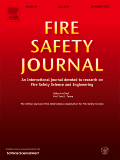
Fire Safety Journal
Scope & Guideline
Advancing knowledge for a safer tomorrow.
Introduction
Aims and Scopes
- Fire Dynamics and Behaviour:
Research focusing on the mechanisms of fire spread, flame dynamics, and combustion characteristics in various materials and environments, including wildfires, structural fires, and confined spaces. - Fire Safety Engineering and Design:
Papers exploring the principles of fire safety engineering, including performance-based design, fire resistance of materials, and structural response under fire conditions. - Fire Detection and Suppression Systems:
Studies on the development and effectiveness of fire detection technologies, suppression methods, and the optimization of firefighting strategies in various scenarios. - Risk Assessment and Management:
Research aimed at evaluating fire risks, assessing the impact of fire incidents, and developing strategies for risk mitigation in urban and rural settings. - Human Factors in Fire Safety:
Investigations into human behavior during fire emergencies, including evacuation processes, decision-making, and the influence of social dynamics on fire safety. - Innovative Materials and Fire Retardants:
Exploration of new materials and chemical agents designed to enhance fire resistance and safety, including studies on char formation, intumescent coatings, and bio-derived fire retardants.
Trending and Emerging
- Advanced Computational Modeling:
There is a growing emphasis on utilizing computational fluid dynamics (CFD) and machine learning techniques to simulate fire behavior, predict outcomes, and enhance fire safety design. - Sustainability and Eco-Friendly Materials:
Research into environmentally friendly materials and methods for fire protection is on the rise, aligning with global sustainability goals and the need for greener fire safety solutions. - Fire Safety in Urban Settings:
An increased focus on urban fire safety challenges, including the complexities of high-rise buildings, wildland-urban interfaces, and community preparedness against fire hazards. - Interdisciplinary Approaches to Fire Safety:
Emerging studies are integrating insights from psychology, engineering, and environmental science to address the multifaceted nature of fire safety challenges. - Fire Safety in the Context of Climate Change:
Research investigating the effects of climate change on fire behavior, risk assessment, and management strategies is becoming increasingly relevant in the journal's publications.
Declining or Waning
- Traditional Firefighting Techniques:
Research on conventional firefighting methods has decreased, likely due to the rise of innovative suppression technologies and a focus on proactive fire prevention strategies. - Historical Fire Incident Studies:
Papers analyzing historical fire incidents appear less frequently, suggesting a shift towards more predictive and preventative approaches rather than retrospective analyses. - General Fire Safety Regulations:
Publications focusing solely on existing fire safety codes and regulations have waned, indicating a movement towards research that integrates regulatory frameworks with advanced engineering practices.
Similar Journals

INTERNATIONAL POLYMER PROCESSING
Pioneering Research in the World of Polymers and PlasticsINTERNATIONAL POLYMER PROCESSING, published by WALTER DE GRUYTER GMBH, serves as a crucial platform for professionals and researchers in the fields of Chemical Engineering, Industrial and Manufacturing Engineering, and Materials Science, particularly focusing on polymers and plastics. With its ISSN 0930-777X and E-ISSN 2195-8602, this journal has been in circulation since 1988 and continues to expand its contributions to contemporary research trends through to 2024. Ranking in the third quartile across multiple categories, including Chemical Engineering (miscellaneous) and Materials Chemistry, it offers insightful and rigorous peer-reviewed articles that enhance the understanding of polymer processing technologies and innovations. This journal is vital for anyone engaged in polymer science and engineering, providing both theoretical and practical perspectives that advance the field. Although it does not provide open access, the journal's content is indispensable for academia and industry professionals looking to stay at the forefront of polymer research.
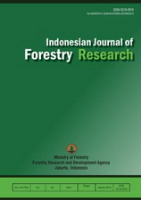
Indonesian Journal of Forestry Research
Pioneering ecological insights for a greener Indonesia.The Indonesian Journal of Forestry Research is a distinguished, peer-reviewed academic journal published by the Ministry of Environment & Forestry of Indonesia. With an ISSN of 2355-7079 and E-ISSN 2406-8195, this journal has been an Open Access platform since 2014, fostering international collaboration and knowledge sharing in the fields of ecology and forestry. As of 2023, the journal holds a respectable Q3 category in both Ecology and Forestry, reflecting its contribution to the science community. It ranks #99/174 in Forestry and #305/461 in Ecology in Scopus, indicating its growing influence in the respective fields. Aimed at researchers, professionals, and students, the Indonesian Journal of Forestry Research provides vital insights and findings, supporting sustainable forestry practices and environmental management in Indonesia and beyond. With an emphasis on innovative methodologies and applied research, this journal stands as a pivotal resource for those dedicated to advancing forestry science and ecological research.

Fire-Switzerland
Connecting researchers and policymakers for a safer tomorrow.Fire-Switzerland is a renowned, peer-reviewed academic journal published by MDPI, focusing on critical issues intersecting the fields of fire safety, environmental science, and forestry. Launched in 2018, this Open Access journal provides a platform for innovative research and practical solutions that address the complexities of fire in various ecosystems and urban environments. With an impressive standing, it has achieved notable quartile rankings, including Q1 in Forestry and Q2 in multiple categories such as Building and Construction, Earth and Planetary Sciences, and Safety Research as of 2023. Geographically rooted in Switzerland, Fire-Switzerland aims to foster international discourse and collaboration among researchers, professionals, and policymakers dedicated to enhancing fire management and safety practices. By making its content freely accessible to a broader audience, the journal plays a pivotal role in advancing knowledge and promoting awareness of fire-related challenges and innovations globally.

ENGINEERING JOURNAL-AMERICAN INSTITUTE OF STEEL CONSTRUCTION
Elevating Construction Standards with Cutting-Edge Research.ENGINEERING JOURNAL-AMERICAN INSTITUTE OF STEEL CONSTRUCTION, published by the American Institute of Steel Construction, stands as a vital resource for researchers, practitioners, and students in the fields of Building and Construction as well as Civil and Structural Engineering. With a history tracing back to its convergence in 1968 and an ongoing commitment to advancing engineering knowledge up to 2024, the journal is indexed under the ISSN 0013-8029. Despite its current open access status, the journal carries significant scholarly weight, reflected in its Q3 ranking in both relevant categories for 2023 and Scopus rankings indicating robust academic relevance within its sectors. The publication aims to disseminate innovative research, practical insights, and critical reviews that contribute to the enhancement of steel construction and infrastructure development. Situated in the heart of Chicago, the journal's dedicated focus on steel's pivotal role in engineering design and application forms an essential part of the conversation around modern building practices and sustainability challenges in the construction industry.
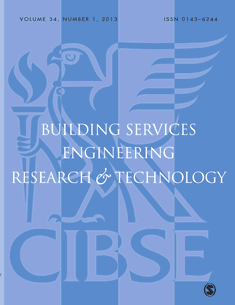
Building Services Engineering Research & Technology
Shaping Tomorrow’s Building Services Through Rigorous ResearchBuilding Services Engineering Research & Technology is a leading journal published by SAGE Publications Ltd, dedicated to advancing the field of building services engineering. With an ISSN of 0143-6244 and an E-ISSN of 1477-0849, the journal has established itself as a vital resource since its inception in 1980, operating as an essential platform for disseminating high-quality research and technological innovations up to 2024. The journal is well-respected within the academic community, reflected in its Q2 category ranking in Building and Construction and a commendable 67th percentile rank among the 223 journals in its field, according to Scopus. Although it does not offer open access, it provides extensive insights and rigorous studies that are invaluable for researchers, practitioners, and students alike. As a central hub for the exploration of cutting-edge methods and principles in building services, the journal aims to foster a better understanding of sustainable and innovative practices within the industry.
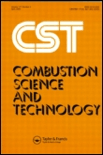
COMBUSTION SCIENCE AND TECHNOLOGY
Pioneering the Future of Energy and CombustionCOMBUSTION SCIENCE AND TECHNOLOGY, published by Taylor & Francis Inc, is a pivotal journal in the fields of Chemical Engineering and Chemistry, with a robust history spanning from 1969 to 2024. With an established impact factor and a strong reputation reflected in its Q2 ranking in both Chemical Engineering and Chemistry, this journal serves as an essential resource for researchers and professionals dedicated to the intricacies of combustion processes and energy technologies. The journal also holds commendable rankings in Energy Engineering, Fuel Technology, and Physics and Astronomy, showcasing its interdisciplinary relevance. While currently not an open-access publication, it offers a wealth of knowledge through its meticulously peer-reviewed articles, which are crucial for advancing understanding and innovation in combustion science. With a commitment to promoting rigorous research and fostering scholarly communication, COMBUSTION SCIENCE AND TECHNOLOGY is indispensable for anyone seeking cutting-edge insights into combustion phenomena and their applications in various engineering fields.

Curved and Layered Structures
Exploring the Intersection of Art and EngineeringCurved and Layered Structures, published by DE GRUYTER POLAND SP Z O O, is a distinguished open-access journal that has been an essential platform since 2014 for academics and professionals in the fields of Aerospace Engineering, Architecture, Building and Construction, Civil and Structural Engineering, and Computational Mechanics. With an ISSN of 2353-7396, it is recognized for its impactful contributions, reflected in its impressive category quartiles, particularly Q1 in Architecture and notable rankings in various engineering disciplines. The journal's scope encompasses innovative research focusing on the intricate designs and applications of curved and layered structures, making it pivotal for advancing knowledge in these areas. The open-access format ensures widespread dissemination of research findings, promoting accessibility and collaboration among researchers and practitioners worldwide. As it navigates its converged years from 2014 to 2024, Curved and Layered Structures continues to attract high-quality submissions that push the boundaries of engineering and architectural design.
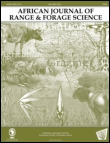
AFRICAN JOURNAL OF RANGE & FORAGE SCIENCE
Unveiling Insights for Ecological SustainabilityAFRICAN JOURNAL OF RANGE & FORAGE SCIENCE is a premier scholarly publication dedicated to the fields of animal science, zoology, and ecology, published by TAYLOR & FRANCIS LTD. With a notable impact factor and categorized in the Q2 quartile for both Animal Science and Ecology, this journal is essential for disseminating cutting-edge research that addresses the complexities of forage management and its ecological implications across the African continent. Established in 1993 and continuing to engage with the latest advancements through to 2024, it serves as a vital platform for researchers, practitioners, and students to share innovative findings and practical applications. The journal not only fosters collaboration among scientists but also emphasizes the importance of sustainable practices in range management, providing insights that have broader implications for environmental conservation. Although it is not currently open access, the journal remains a respected entity in academic circles, with Scopus rankings reflecting its significant contribution to the scientific community. Readers are encouraged to explore its rich repository of research to inform and inspire future studies in these crucial areas.

FIRE TECHNOLOGY
Illuminating the Path to Enhanced Fire SafetyFIRE TECHNOLOGY is a prestigious peer-reviewed journal published by SPRINGER, focusing on the integral aspects of fire sciences and engineering. With its longstanding history from 1965 to 2024, the journal aims to advance the understanding of fire phenomena, enhancing safety and risk management practices in both engineering and materials science fields. Serving as an essential resource for researchers, professionals, and students alike, FIRE TECHNOLOGY currently holds a Q2 ranking in both Materials Science (miscellaneous) and Safety, Risk, Reliability, and Quality categories as per the 2023 Category Quartiles report. Additionally, it ranks #36 out of 207 in Safety, Risk, Reliability and Quality within Scopus, emphasizing its significant impact and reach in the scientific community. Although it operates under a traditional access model, FIRE TECHNOLOGY contributes invaluable knowledge that promotes the innovation of safer materials and practices in addressing fire hazards. Its dedicated focus continues to inspire advancements in fire technology and enhance societal safety, making it an indispensable publication for those invested in these critical fields.
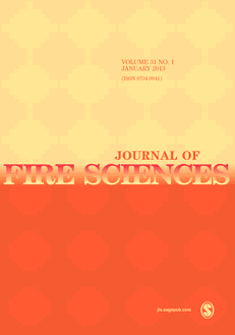
JOURNAL OF FIRE SCIENCES
Elevating standards in fire science research.The JOURNAL OF FIRE SCIENCES, published by SAGE PUBLICATIONS LTD, is a leading scholarly platform that has been advancing the understanding of fire dynamics, safety measures, and material behaviors since its inception in 1983. With an impact factor that reflects its rigorous peer-review standards and significant contributions to the fields of Mechanical Engineering, Mechanics of Materials, and Safety, Risk, Reliability, and Quality, this journal is rated Q2 in its respective categories as of 2023. Researchers and professionals will find valuable insights that span theoretical frameworks and practical applications, encouraging the development of innovative fire safety solutions. With its commitment to disseminating high-quality, impactful research, the JOURNAL OF FIRE SCIENCES stands as an essential resource for those dedicated to enhancing fire safety and risk management practices worldwide. For more information about submission guidelines and access options, please visit the journal's official page.